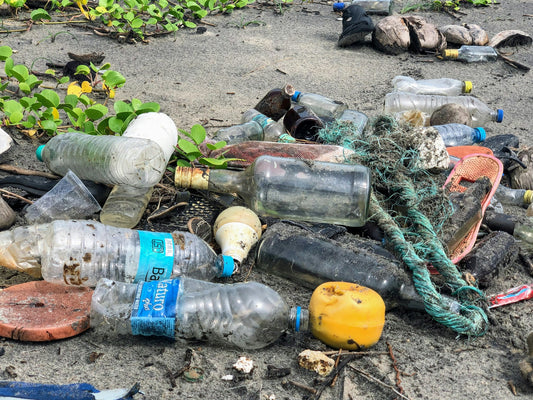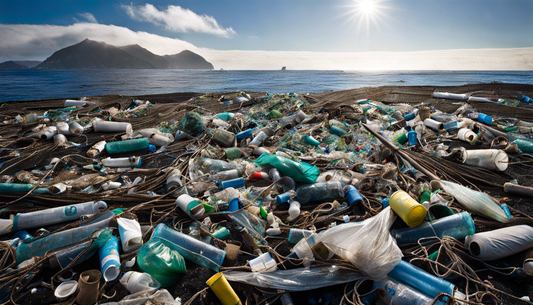
Is Chewing Gum Made of Plastic?
Share
Have you ever wondered what chewing gum is made of?
It is somehow amazing that we pop in these chewy, minty treats, without really knowing what's inside.
The package usually shows several additives that are all greek to us and a frequently held perception even says that chewing gum contains plastic. Let's find out if that is really the case.

Where it Began & Now
As a popular activity that humans have taken up for generations, chewing gum finds its roots in ancient civilizations such as the Greeks and the Mayans, who would consume whatever natural products brought them both enjoyment and health benefits.
Nowadays, chewing gum is one of the most capitalized products in the world, with billions in revenue and innumerable flavors from different brands being found everywhere.
Research studies have methodically looked at how chewing gum positively influences various aspects of oral health, digestion, and cognition.
Others argue that chewing gum can be used to increase attentiveness or even recall. Additionally, saliva secretion caused by chewing is thought to play a role in the digestion process and acid reflux removal. Yet, over-prolonged gum chewing may be risky because of the possibility of developing jaw problems and headaches.
Statistics show that most humans opt for gum as their favorite candy. Gum chewing is a widespread habit in the United States, and according to one study about 70% of the population consume chewing gum, with the average person chewing over 280-300 pieces per year.
Let's find out, what it actually is that we chew on.
What is Chewing Gum Made of?

No matter their age, everyone enjoys sweets. Its unusual chewy texture and strong taste make chewing gum a favored snack for freshening breath and calming tension. But did you realize how many ingredients are needed to make this enjoyable treat?
The gum base is essential to chewing gum's texture. It consists of an insoluble base coat and includes a composition of natural and synthetic elastomers, resins, emulsifiers, and paraffin wax.
These components are then melted together and they give the gum the typical chewy and stretchy texture in the mouth.
In addition to the chewing gum base, various additional chemicals give gum its acidity and juiciness.
Sugar or artificial sweeteners are used to sweeten gum. Synthetic sugars like aspartame and sucralose contrast with natural sugars like cane sugar. According to a study, chewing gums can also include softeners that are commonly utilized to keep gum tender.
Glycerin or vegetable oil serve a similar purpose, keeping the gum supple and lasting through hard chewing. Without softeners, gum would become brittle and taste bad.
Finally, the product is flavored at the final stage of production before storage to make it taste great. Conventional mint and fruit flavors, as well as the more unusual flavors such as cinnamon and bubble gum, are among these flavorings.
The list of these ingredients has stayed similar over many decades and is what made chewing gum loved among people for years.
In short, the next time you open that pack of gum for a quick snack, be mindful of all the ingredients that come together to make such a simple treat.
Does Chewing Gum Contain Harmful Ingredients Like Plastic?
As we mentioned above, one of the main ingredients of the gum base is elastomers, which is just a short form of “elastic polymers”. In other words, the main ingredient in cheing gum is a form of plastic.
The most commonly used elastomer in fact is polyvinyl acetate, which makes up 60% of many chewing gums, and it is also used in the production of plastic bags, bottles, and glues.
This can lead to worrying release of microplastics and plastic-related chemicals like pthalates into your body.
Furthermore, the rest of the gum is made with sugar and softeners for a sweeter and softer texture, ultimately making it not a go-to snack for health-conscious people. Excessive use of sugar/sweeteners in your gum can spike up your glucose levels.
Is Chewing Gum Biodegradable?

As most plastics, chewing gum is not biodegradable. Once it is littered, it stays around for many years and even centuries.
While non-biodegradable chewing gum can be a severe problem for the environment, it can also cause long-term challenges in terms of inner-city 'gum pollution".
Who hasn't strolled through the city and suddenly felt a sticky something on their shoe? Unfortunately, the environmental impact of cheing gum goes far beyond that annoyance.
Environmental Impact of Chewing Gum
Gum is environmentally harmful for more than just its biodegradability.
One of the most apparent forms in which gum is unethically left is that it gets stuck to the surfaces of the floor(s), which makes it impossible for others to remove them, accidentally resulting in littering and environmental pollution.
For this reason, chewing gum in public places is banned in some countries, such as Singapore. Furthermore, gum pollution is a significant source of marine waste contamination in many urban areas, as it is swept away after being littered
.
Alternatives to Traditional Chewing Gum
"Do you want to reduce your contribution to environmental pollution caused by traditional chewing gum?"
Some options may be helpful. Certain manufacturers sell gum made from so called Manilkara Sapota Tree Resin, called chicle. Furthermore, other alternatives are healthy and equally delicious, such as Licorice, Organic Mints Seeds, and Nuts.
Conclusion
Chewing gum may offer some health benefits. However, you must consider the drawbacks as well. Conventional synthetic chewing gum can release toxins and has an adverse environmental impact as it is not biodegradable.
This makes chewing gum neither a healthy nor an eco-friendly snack. Though biodegradable chewing gums have been introduced, they are not available everywhere.
Next time you chew gum, consider how it affects your health and the world. By using biodegradable gums and proper gum disposal, we can all work together to reduce the worldwide environmental impact of our favorite snacks. Next time you grab gum, consider the repercussions and choose wisely.
To minimize cavities, use sugar-free gum, and look for natural and biodegradable products to reduce environmental impact.
We hope you enjoyed this article. If you want to read more like this, make sure to check out our Blog and follow us on Instagram. If you are interested in truly sustainable products, check out our Shop.
If you want to engage in the discussion, feel free to leave a comment below.







